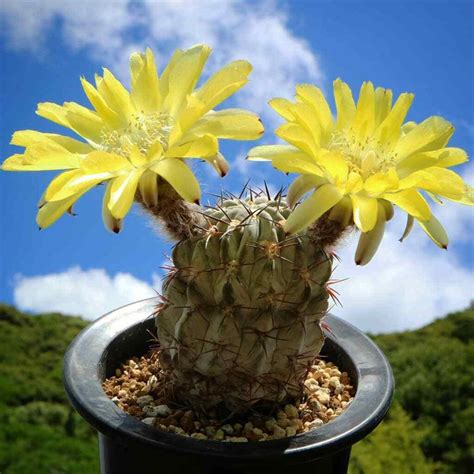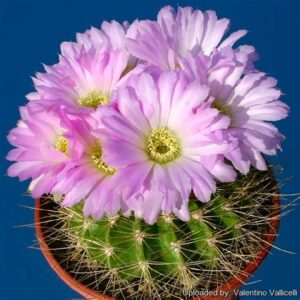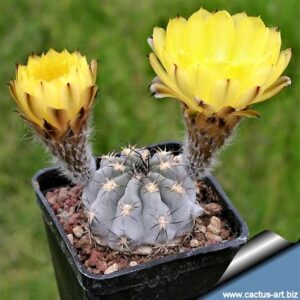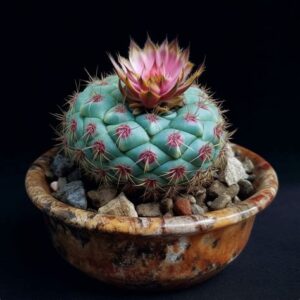Hailing from the arid expanses of South America, the Acanthocalycium catamarcense stands as a testament to nature’s resilience and beauty. This cactus, with its strikingly spiny exterior and vibrant blooms, is akin to a fortress adorned with the colors of spring. To cultivate this captivating plant requires more than basic horticultural skills; it demands an understanding of its unique needs, much like deciphering the elusive language of a seasoned storyteller.
In this intricate narrative of care, we will explore the optimal strategies for growing and maintaining Acanthocalycium catamarcense, ensuring that your gardening journey is as enriching as the outcome itself.
Understanding the Essence of Acanthocalycium Catamarcense
The charm of Acanthocalycium catamarcense lies in its inherent characteristics. This succulent exhibits a globular form, often developing into a barrel-like shape as it matures. Like a cherished heirloom, its body is adorned with spines of varying hues, creating a visual tapestry that delights the eye. When in bloom, the vibrant flowers present an enchanting display of color, reminiscent of a painter’s palette splashed with yellows, greens, and pinks. This beauty, however, masks a resilience that speaks volumes about its adaptability and survival instincts.
The natural habitat of this species, typically found in rocky terrains and dry climates, influences its care requirements significantly. Understanding these environmental preferences is akin to unraveling the threads of an intricate tapestry woven from the elements of water, light, and soil.
Creating an Ideal Habitat: Soil, Sunlight, and Space
To successfully cultivate Acanthocalycium catamarcense, one must first create an environment that mirrors its native habitat. The soil is the foundation upon which your plant thrives. This cactus flourishes in well-draining soil that resembles a sandy desert floor. A blend of cactus mix with added perlite or coarse sand can facilitate adequate drainage, preventing the roots from becoming waterlogged—much like a ship’s hull that requires a steady flow of seawater to remain buoyant.
Sunlight, another vital element, plays a pivotal role in this cactus’s growth. Acanthocalycium catamarcense delights in direct sunlight, yearning for at least six hours of exposure daily. Positioning your cactus near a south-facing window can simulate the brilliant rays of the sun that shower its natural habitat. However, be cautious during the intense summer months; consider filtering the glare with sheer curtains to prevent sunburn on the delicate skin of your plant.
Space is equally important. This species can grow quite large, reaching sizes of up to a foot in diameter. Gardening is not unlike composing a symphony; each element should harmonize with the others. Placing your cactus generously away from other plants will afford it the room to flourish while minimizing competition for nutrients and light.
The Water Ballet: A Delicate Balance
Watering Acanthocalycium catamarcense entails a dance—a careful balance between too much and too little. Like a master choreographer, one must learn the specific rhythm that our cactus prefers. During the growing season, which typically spans from spring to early autumn, the cactus should be watered thoroughly, allowing the soil to dry out completely between waterings. This practice mimics the seasonal rains that may bless its native habitat, followed by prolonged periods of dryness.
In contrast, the winter months bring about a dormant phase for Acanthocalycium catamarcense, demanding a drastic reduction in water intake. It is essential to allow the plant to rest, mirroring the natural cycles of nature—periods of growth and periods of dormancy. This act of restraint honors the needs of the cactus and nurtures its longevity.
Feeding Your Cactus: The Nutritional Symphony
Providing nutrition to Acanthocalycium catamarcense resembles orchestrating a symphony; each instrument must play its part harmoniously. While these cacti can thrive in lean soils, they benefit from a periodic infusion of nutrients during their active growth phase. A balanced fertilizer, diluted to half strength, can be applied every four to six weeks from spring through summer. This fortification empowers the cactus to produce those exquisite blooms, reminiscent of a crescendo in a beautifully composed piece of music.
However, excess can harm. Over-fertilization may lead to a toxic buildup in the soil, akin to an orchestra that has been pushed beyond its limits, resulting in a cacophony rather than a melody. Always err on the side of caution, for the journey of nurturing is one of subtlety and respect for the plant’s needs.
Pest Management: The Unwanted Visitors
Like a story that takes an unexpected twist, the presence of pests can intrude upon the serene existence of your cactus. Common invaders include mealybugs and spider mites, each seeking to sap the vitality of your beloved plant. Vigilance is paramount; inspecting your cactus regularly can help you catch these pests before they become a full-fledged infestation.
If you discover unwelcome visitors, a gentle solution is often most effective. A mixture of water and mild soap can be sprayed on the affected areas, acting like a thoughtful guardian warding off intruders. Ensure you rinse the cactus thoroughly afterward to avoid any residual soap that could cause harm. For more stubborn infestations, consider introducing beneficial insects, such as ladybugs, which can aid in keeping your cactus free from pests while coexisting in a delicate ecological balance.
Propagation: The Art of Rebirth
As autumn approaches and the colors of your Acanthocalycium catamarcense transform, you may feel compelled to propagate your cactus—a desire to share its beauty with others. This process mirrors the cycles of nature and the themes of rebirth inherent in gardening. The Acanthocalycium catamarcense can be propagated from seeds or offsets, and each method holds its unique charm.
When propagating from seeds, patience is key. The seeds are sown in a well-draining soil mix and lightly watered, placed in a warm, bright location, where they can slowly awaken. As the seedlings emerge, they symbolize hope and new beginnings, echoing the promises of the season.
If you choose to propagate through offsets, gently remove the smaller pups that grow around the base of the mother plant. Allow these offsets to callous over for a few days before planting them in fresh soil. This action not only expands your cactus collection but serves as an homage to the vitality of life that this resilient species embodies.
Conclusion: A Living Portrait of Nature
Caring for Acanthocalycium catamarcense encapsulates a journey through the rich narrative of plant stewardship. Each element—soil, sunlight, water, and nutrition—plays a vital role in the intricate dance of growth and sustenance. The unique appeal of this cactus lies not only in its striking appearance but also in the relationship cultivated between gardener and plant. By understanding and honoring the needs of the Acanthocalycium catamarcense, you participate in a story that weaves together the delicate threads of biodiversity, resilience, and beauty—elements that are often lost in the fast-paced world outside your garden.
As you tend to your cactus with care, remember that it, too, is a part of this intricate narrative—a living portrait of nature that thrives under your watchful eye and nurturing hands.





Leave a Comment